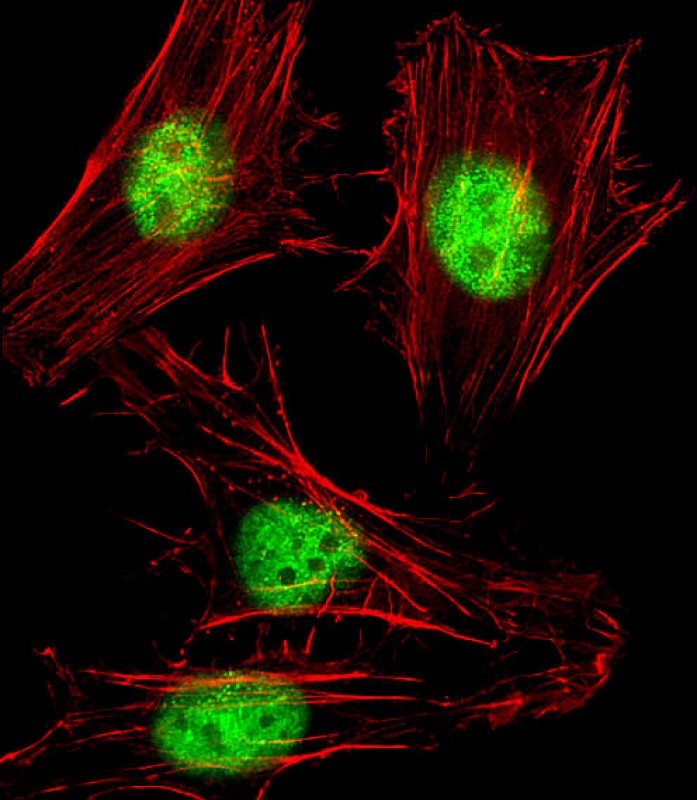

| WB | 1/2000 | Human,Mouse,Rat |
| IF | 咨询技术 | Human,Mouse,Rat |
| IHC | 咨询技术 | Human,Mouse,Rat |
| ICC | 1/25 | Human,Mouse,Rat |
| FCM | 咨询技术 | Human,Mouse,Rat |
| Elisa | 咨询技术 | Human,Mouse,Rat |
| Aliases | SNW domain-containing protein 1, Nuclear protein SkiP, Nuclear receptor coactivator NCoA-62, Ski-interacting protein, SNW1, SKIIP, SKIP |
| Entrez GeneID | 22938 |
| WB Predicted band size | 61.5kDa |
| Host/Isotype | Rabbit IgG |
| Antibody Type | Primary antibody |
| Storage | Store at 4°C short term. Aliquot and store at -20°C long term. Avoid freeze/thaw cycles. |
| Species Reactivity | Human, Mouse |
| Immunogen | This SNW1 antibody is generated from a rabbit immunized with a KLH conjugated synthetic peptide between 464-497 amino acids from human SNW1. |
+ +
以下是关于SNW1抗体的3篇参考文献的简要总结:
---
1. **文献名称**: "SNW1 is a critical regulator of spatial BMP activity, neural plate border formation, and neural crest specification in vertebrate embryos"
**作者**: Bonano et al.
**摘要**: 该研究利用斑马鱼和小鼠模型,通过SNW1抗体进行免疫沉淀和Western blot分析,揭示了SNW1在调控BMP信号通路及神经嵴细胞分化中的关键作用。
---
2. **文献名称**: "The splicing factor SNW1 regulates the expression of MDM2 and CDKN1A in a p53-dependent manner"
**作者**: Albor et al.
**摘要**: 研究通过免疫荧光和染色质免疫共沉淀(ChIP)技术结合SNW1抗体,证明SNW1通过调控p53下游基因(如MDM2和CDKN1A)的剪接,影响细胞周期和肿瘤发生。
---
3. **文献名称**: "SNW1 interacts with p53 and modulates its transcriptional activity"
**作者**: Li et al.
**摘要**: 该文献使用SNW1抗体进行免疫组化(IHC)和共聚焦显微镜分析,发现SNW1通过与p53直接相互作用调节其转录活性,在DNA损伤应答中发挥重要作用。
---
**备注**:若需具体文献来源或补充更多研究,可进一步检索PubMed或Sci-Hub数据库,关键词包括“SNW1 antibody application”或“SNW1 protein interaction”。
The SNW1 antibody is a crucial tool for studying the SNW1 protein (SNW domain-containing protein 1), also known as SKI-interacting protein (SKIP). SNW1 is a multifunctional nuclear protein involved in transcriptional regulation, pre-mRNA splicing, and cellular signaling pathways. It interacts with components of the RNA splicing machinery, transcription factors (e.g., Retinoid X Receptor, Notch), and signaling mediators (e.g., TGF-β, Hedgehog), playing roles in cell cycle progression, differentiation, and stress responses. Dysregulation of SNW1 is linked to cancers, neurodegenerative disorders, and developmental defects, with studies highlighting its dual role as an oncogene or tumor suppressor depending on context.
SNW1 antibodies, typically produced in rabbits or mice, enable detection of SNW1 expression, localization, and protein interactions via techniques like Western blotting, immunohistochemistry, immunofluorescence, and co-immunoprecipitation. These antibodies are vital for investigating SNW1's molecular mechanisms in disease models, particularly its spliceosome-related functions and crosstalk with signaling pathways. Validation includes testing specificity in SNW1-knockdown cells or tissues. Research utilizing SNW1 antibodies has advanced understanding of its contributions to transcriptional elongation, RNA processing, and therapeutic targeting in malignancies, making it essential for both basic and translational biomedical studies.
×